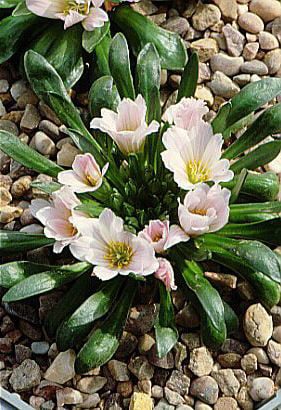Size
Ultimate height
Up to 10cmTime to ultimate height
2–5 yearsUltimate spread
0–0.1 metreGrowing conditions
Moisture
Well–drainedpH
Acid, NeutralColour & scent
| Stem | Flower | Foliage | Fruit | |
| Spring | Pink White | Green | ||
|---|---|---|---|---|
| Summer | Pink White | |||
| Autumn | Green | |||
| Winter | Green |
Position
- Full sun
Aspect
South–facing or East–facing
Exposure
Exposed Hardiness
H4Botanical details
- Family
- Montiaceae
- Native to GB / Ireland
- No
- Foliage
- Deciduous
- Habit
- Tufted
- Genus
Lewisia can be herbaceous or evergreen perennials forming rosettes of fleshy leaves, with panicles of open funnel-shaped flowers in a wide range of colours in spring and summer
- Name status
Correct
- Plant range
- SW USA
How to grow
Cultivation
Grow in moderately fertile, humus-rich, very well-drained, neutral to acid soil in full sun; a gravel top-dressing helps to keep foliage dry. Protect from winter wet; dies down in summer when it needs protecting from rain because it is dormant. Suitable for cultivation in a container in an alpine house
Propagation
Propagate by seed sown in pots in a cold frame in autumn
Suggested planting locations and garden types
- Patio and container plants
- Gravel garden
- Rock garden
- Wall side borders
Pruning
Deadhead after flowering
Pests
May be susceptible to aphids under glass and to slugs and snails outdoors
Diseases
Prone to neck rot in wet conditions
Love gardening
Sign up to receive regular gardening tips, inspiration, offers and more
View our Privacy Policy
Get involved
The Royal Horticultural Society is the UK’s leading gardening charity. We aim to enrich everyone’s life through plants, and make the UK a greener and more beautiful place.
